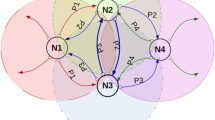Abstract
The potential game as a special type of game, compared to other types of game, has the finite increment property, the existence and uniqueness of Nash equilibrium and other good properties and can be used to solve the problem of resource allocation in cognitive radio networks (CRNs). Broadcast retransmission is a important function in CRNs, which need to be optimized in order to improve the efficiency and utilization of the networks. When packets failed to reach some receivers in broadcasting, retransmission occurs. Choosing an appropriate channel to delivery packages is critical to the efficiency and quality of data retransmission. In this paper, first, we establish a potential game model for broadcasting retransmission by taking into account of energy consumption and interference in the design of utility function and potential function in spectrum allocation. Then we propose Potential Game-Broadcasting Retransmission Algorithm (PG-BRA) based on potential game model. In PG-BRA, two broadcast retransmission mechanisms are designed to avoid “conflict” problems, named FRM and DRM. FRM is more suitable for static network topology and DRM is more suitable for dynamic network topology. The simulation results show that the PG-BRA proposed in this paper can effectively work in terms of packet reach rate, average retransmission times, average delay and the total transmission power of system compared with existing broadcasting scheme.







Similar content being viewed by others
References
Ouyang, B., Hong, X., & Yi, Y. (2005). A Comparison of reliable multicast protocols for mobile ad hoc networks. In: SoutheastCon, 2005. Proceedings. IEEE (pp. 339–334).
Velayudham, A., Gohila, G. V. S., Hariharan, R., & Ramya Selvi, M. M. (2014). A novel coalition game theory based resource allocation and selfish attack avoidance in cognitive radio ad-hoc networks. Journal of Theoretical and Applied Information Technology, 64(1), 180–189. https://doi.org/10.1049/ic.2013.0363.
Al-Imari, M., Ghoraishi, M., & Xiao, P. (2015). Radio resource allocation for full-duplex multicarrier wireless systems. In: Proceedings of the International Symposium on Wireless Communication Systems (Vol. 2016CApril, pp. 571–575). https://doi.org/10.1109/ISWCS.2015.7454410.
Monderer, D., & Shapley, L. S. (1996). Potential games. Games and Economic Behavior, 14(1), 124–143. https://doi.org/10.1006/game.1996.0044.
Voorneveld, M. (2000). Best-response potential games. Economics Letters, 66(3), 289–295. https://doi.org/10.1016/S0165-1765(99)00196-2.
Nie, N., & Comaniciu, C. (2006). Adaptive channel allocation spectrum etiquette for cognitive radio networks. Mobile Networks and Applications, 11(6), 779–797. https://doi.org/10.1007/s11036-006-0049-y.
La, Q. D., Chew, Y. H., & Soong, B. H. (2009). An interference minimization game theoretic subcarrier allocation algorithm for OFDMA-based distributed systems. In: GLOBECOM—IEEE Global Telecommunications Conference. https://doi.org/10.1109/GLOCOM.2009.5425911.
Scutari, G., Barbarossa, S., & Palomar, D. P. (2006). Potential games: A framework for vector power control problems with coupled constraints. In: IEEE International Conference on Acoustics Speech and Signal Processing (ICASSP) (pp. 17–25).
Heikkinen, T. (2006). A potential game approach to distributed power control and scheduling. Computer Networks, 50(13), 2295–2311. https://doi.org/10.1016/j.comnet.2005.09.010.
Fan, S., Zhang, L., Wang, Y., & Ren, Y. (2012). Potential game based transmission method for wireless multi-hop networks. Application Research of Computers, 29(3), 1014–1018.
Stojmenovic, I., Seddigh, M., & Zunic, J. (2002). Dominating sets and neighbor elimination-based broadcasting algorithms in wireless networks. IEEE Transactions on Parallel and Distributed Systems, 13(1), 14–25.
Chang, B. J., Liang, Y. H., & Huang, Y. D. (2017). Efficient emergency forwarding to prevent message broadcasting storm in mobile society via vehicle-to-X communications for 5G LTE-V. In: Proceedings—2016 International Computer Symposium, ICS 2016 (pp. 479–484). https://doi.org/10.1109/ICS.2016.0102.
Zhang, Q., & Agrawal, D. P. (2005). Dynamic probabilistic broadcasting in MANETs. Journal of Parallel and Distributed Computing, 65(2), 220–233. https://doi.org/10.1016/j.jpdc.2004.09.006.
Zhang, X. M., Wang, E. B., Xia, J. J., & Sung, D. K. (2013). A neighbor coverage-based probabilistic rebroadcast for reducing routing overhead in mobile ad hoc networks. IEEE Transactions on Mobile Computing, 12(3), 424–433. https://doi.org/10.1109/TMC.2011.277.
Yassein, M. B., Nimer, S. F., & Al-Dubai, A. Y. (2011). A new dynamic counter-based broadcasting scheme for mobile ad hoc networks. Simulation Modelling Practice and Theory, 19(1), 553–563. https://doi.org/10.1016/j.simpat.2010.08.011.
Ahlswede, R., Cai, N., Li, S.-Y. R., & Yeung, R. W. (2000). Network information flow. IEEE Transactions on Information Theory, 46(4), 1204–1216. https://doi.org/10.1109/18.850663.
Xiao, X., Yang, L. M., Wang, W. P., & Zhang, S. (2008). A wireless broadcasting retransmission approach based on network coding. In: 2008 4th IEEE International Conference on Circuits and Systems for Communications, ICCSC (pp. 782–786). https://doi.org/10.1109/ICCSC.2008.171.
Tsiropoulos, G. I., Dobre, O. A., Ahmed, M. H., & Baddour, K. E. (2016). Radio resource allocation techniques for efficient spectrum access in cognitive radio networks. IEEE Communications Surveys Tutorials, 18(1), 824–847. https://doi.org/10.1109/COMST.2014.2362796.
Zhao, Z. Z. Z., Peng, Z. P. Z., Zheng, S. Z. S., & Shang, J. S. J. (2009). Cognitive radio spectrum allocation using evolutionary algorithms. IEEE Transactions on Wireless Communications, 8(9), 4421–4425. https://doi.org/10.1109/TWC.2009.080939.
Liu, H., Li, J., & Liu, H. (2014). High loss improved broadcasting retransmission approach based on network coding. Advanced Materials Research, 1021(9), 261–265.
Acknowledgements
This work was supported by the Science and Technology Fundament Research Fund of Shenzhen under Grant JCYJ20160318095218091 and JCYJ20170307151807788.
Author information
Authors and Affiliations
Corresponding author
Additional information
Publisher's Note
Springer Nature remains neutral with regard to jurisdictional claims in published maps and institutional affiliations.
Rights and permissions
About this article
Cite this article
Qin, Y., Wang, H. & Wang, Y. Broadcast Retransmission Algorithm Based on Potential Game in CRNs. Wireless Pers Commun 107, 663–678 (2019). https://doi.org/10.1007/s11277-019-06295-0
Published:
Issue Date:
DOI: https://doi.org/10.1007/s11277-019-06295-0




